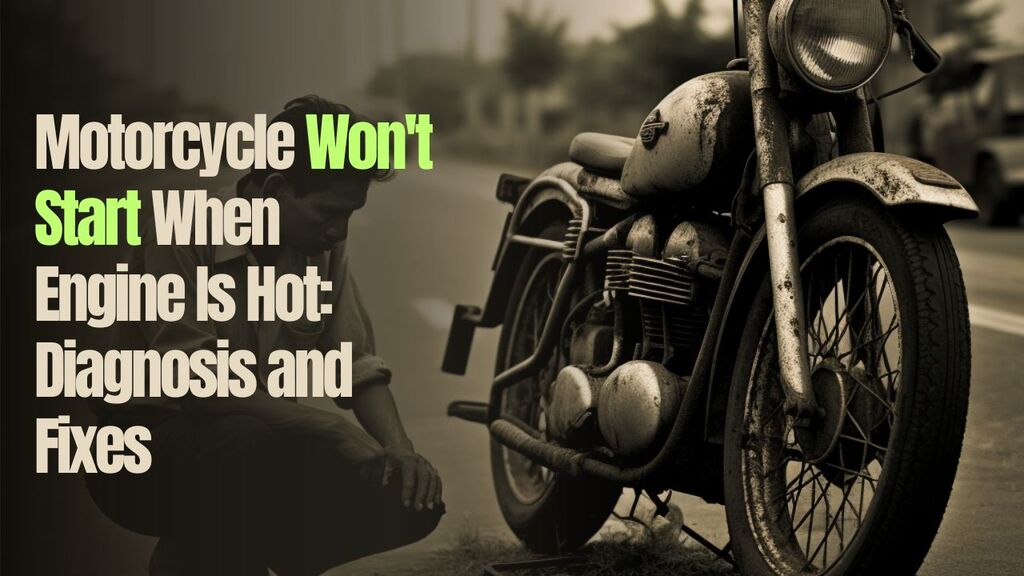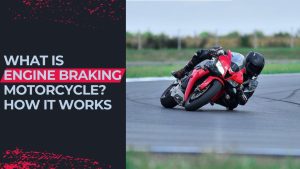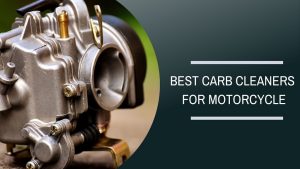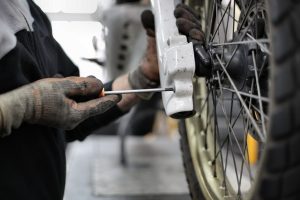Ever been left puzzled by your motorcycle won’t start when engine is hot? We’re here to unravel the complexities behind why your engine balks when hot.
Stay tuned as we gear up to offer you a comprehensive guide—a roadmap to diagnosing and fixing the hot-start blues. Let’s get ready to spark that ignition back to life!
The Basics of Motorcycle Won’t Start When Engine Is Hot
Why does a motorcycle won’t start when the engine is hot? To get to the heart of the matter, we need to tackle the basic necessities for any motorcycle to come to life: air, fuel, spark, and compression. Let’s dive into each one and see how a rise in temperature can be a real problem.
Air: The Breath of Your Engine
Your bike engine needs air to breathe. But it’s not just about quantity; it’s the quality of air and its flow that matter.
When your bike is hot, and I mean stuck-in-traffic-on-a-summer-day hot, the air being sucked in can become warmer and less dense. Less oxygen means the engine has to work harder to maintain the same power.
Now, if your air filter is clogged or the intake isn’t clear, that’s like trying to breathe through a straw on a sprint. It’s not going to end well.
Fuel: The Energy Drink for Your Ride
Now, air alone isn’t enough. Your motorcycle craves fuel, and it’s picky about how it’s served. Cold start? The fuel is dense, and the flow is precise.
But when the engine is hot, fuel can vaporize prematurely, messing up the delicate balance needed for ignition.
Spark: The Sparkle That Starts the Party
A good spark at the right moment ignites the air-fuel mixture, setting the engine in motion. But heat can be a wet blanket over that spark.
High temperatures may lead to electrical resistance, weak sparks, or no spark at all. That’s like having soggy matches on a camping trip.
Compression: Keeping the Power Packed
Lastly, compression. Without proper compression, the air-fuel mix is too loosey-goosey to combust properly. But when your bike’s been running for a while, everything expands, including the gap where your spark plug lives.
If the compression isn’t up to snuff due to wear and tear or overheating, it’s like trying to clap with one hand. Not much is going to happen.
The Heat Factor: A Sticky Situation
So, how does heat throw a wrench in the works? When your motorcycle’s engine is hot, each of these four musketeers of ignition can falter.
Airflows sluggishly, fuel evaporates, spark plugs rebel, and compression seals might as well be on vacation. It’s a classic case of too many cooks in the kitchen—except they’re all on a break just when you need them most.
In the real world, this means that after a glorious ride, if you stop for gas or a quick coffee, coming back to a non-starting motorcycle can be as baffling as it is inconvenient.
But now that you know what’s actually going on under the hood, you’re better equipped to troubleshoot or, better yet, prevent these hot-start woes. Keep your bike’s engine components in check, and they’ll keep your adventures on track.
Electrical Components and Their Heat Challenges
Have you ever wondered why your bike acts like it’s on a coffee break when you’re raring to go? When the sun’s beating down, you might face your motorcycle won’t start when engine is hot.
Let’s get our hands dirty and explore how heat messes with the bike.
Electrical components lose their cool (quite literally) when things get too hot. Heat increases electrical resistance, and that’s bad news for the flow of electric current.
Battery Troubles
High temperatures can cause the chemical reactions inside your battery to go into overdrive.
But here’s a cool tip: keep your battery’s terminals clean. A build-up of gunk is like cholesterol in arteries—no good for energy flow. And when it’s hot, that build-up can get as crusty as old bread. You can clean them with a bit of baking soda and water mixture, just be sure to wear gloves and goggles—safety first!
Checking your battery’s voltage is also a good shout. Grab a voltmeter, and look for a reading of around 12.6 volts. Anything less, and it’s like your battery is trying to sprint with a backpack full of bricks.
Keeping your bike’s battery on a tender when it’s not in use is like giving it a relaxing spa day. It keeps the battery topped up, so it doesn’t drain itself trying to stay alive when the engine’s heat is cranking up the pressure.
Remember, batteries are like bears. They like it cool. So, if you can park your bike in the shade or a garage, do it.
Ignition Woes
When your motorcycle won’t start when engine is hot, you might be dealing with an all-too-common standoff with your ignition system.
Let’s break down these rebellious issues and figure out how to whip them back into shape.
a. Tight Valve Clearance
Imagine you’re trying to sip a thick shake through a narrow straw. Tough, right? That’s what happens when your bike’s valve clearance is too tight—the metaphorical straw for the engine’s breath gets too narrow, especially when things heat up. The metal expands, and suddenly, that little gap where the magic happens is as cramped as a rush-hour subway.
Here’s the fix:
- Cool Down: First, let your engine chill out. You don’t want to work on a hot engine.
- Get the Specs: Check your service manual for the nitty-gritty on your bike’s valve clearance specs.
- Feeler Gauges in Hand: With your engine cool, use feeler gauges to check the clearance. Slip the gauge between the valve stem and the rocker arm or cam—whatever your bike uses.
- Adjust as Needed: If things are too tight, you’ll need to loosen them to the spec listed in your manual.
b. Worn Spark Plugs
Next up are your spark plugs. Think of them as the fire-starters for your bike’s internal party. But when they’re worn out, they’re like trying to light a BBQ with wet matches—not much is going to happen.
To diagnose and change a spark plug:
- Visual Inspection: Pull them out and have a look. A healthy spark plug should have a bit of an ashy deposit, but if it’s oily or blackened, you’ve got issues.
- Check the Gap: Use a spark plug gapper to ensure the gap matches the spec from your manual.
- Replace if Needed: If they’re looking rough, swap them out for some shiny new ones. They’re not too pricey, and your bike will thank you with a purr.
c. Failing Ignition Coils
Ignition coils are like the heart pumping electrical life through your bike. But when they’re on the fritz, especially in the heat, it’s like they’ve run a marathon in the desert.
Here’s what you can do:
- Touch Test: Carefully touch your coils after a ride. If they’re too hot to handle, that’s a red flag.
- Multimeter Magic: Get out your trusty multimeter and check the resistance. Again, your service manual has the specs you need.
- Replace if Necessary: If the numbers are off, it’s time for a new set of coils.
Starter and CDI Box Failures
Let’s set the scene: You’ve had a blissful ride, the sun on your back, the wind in your face. You pull over, grab a quick bite, and then… your bike just hums and whirs, refusing to start. Could be the starter is throwing a tantrum. This little motor’s job is to crank your engine over, but when it’s hot, it can get sticky, like a jammed lock.
Here’s what might be happening:
- Heat Expansion: The heat can cause the starter’s components to expand, making it as tight as a jar lid that just won’t budge.
- Electrical Resistance: As the starter heats up, electrical resistance can increase, making it harder for the current to do its job.
Testing the Starter:
- Listen Up: When you hit the ignition and hear a click instead of the engine turning over, it’s the starter relay saying “I tried, but no dice.”
- Feel the Heat: After a ride, if the starter’s hotter than the rest of the engine, it’s a hint it might be overworking due to internal resistance.
- The Bench Test: If you’re handy with tools, remove the starter and do a bench test. This means hooking it directly to a battery and seeing if it spins freely. No spin, no win—you’ll need a new one.
CDI Box Blues
The CDI (Capacitor Discharge Ignition) box is like the conductor of an orchestra—it tells the spark when to fly. But when it’s got the blues, it can miss the cue, especially when it’s hot. The CDI box is a tough cookie, but age or a factory fault can crack its composure.
Signs of a Failing CDI Box:
- Intermittent Misfires: Like a DJ with hiccups, a failing CDI box can cause the engine to stutter or backfire.
- Total Silence: Worst case, you turn the key, and it’s as quiet as a mouse—no spark to get things going.
Testing the CDI Box:
- Visual Inspection: Check for any burn marks or swelling. It’s like checking an egg before cracking it—you want no surprises.
- Multimeter Test: Not for the faint of heart, but you can use a multimeter to test the CDI box’s resistance. This is complex, so if you’re not a seasoned tinkerer, maybe leave it to the pros.
- Swap Test: The old switcheroo—try swapping it with a known good CDI box and see if your bike springs to life. Just like trying on a different hat to see if it fits better.
When to Call in the Cavalry:
- Over Your Head?: If all this talk of testing and resistance has you scratching your helmet, it might be time to let a mechanic take the reins.
- Warranty Wonders: Got a warranty? Use it. Sometimes it’s better to play it safe and let the warranty work its magic.
Fuel System Faults
Imagine it’s a scorcher of a day, and you’re set to ride. But the high temps are cooking more than just burgers on the grill—they’re stirring up trouble in your bike’s fuel system too. Heat can turn your fuel system into a pressure cooker, leading to all sorts of starting mischief.
a. Vapor Lock and Flooding
Ever had a pen leak in your pocket? A vapor lock is kind of like that, but inside your fuel lines. It’s what happens when fuel gets so hot it turns to vapor before it should, creating a bubble that blocks the flow like a cork in a bottle. Your engine cranks, begging for fuel, but all it gets is a pocket of hot air.
Breaking the Bubble:
- Cool It: Sometimes, the simple fix is to let your bike take a breather in the shade.
- Loosen Up: Crack open the fuel cap. If you hear a hiss, that’s the sound of your fuel system saying “thanks.”
- Burp the Lines: For carbureted bikes, you can often ‘burp’ the lines by pressing the bleed valve to let out trapped air.
Now, a flooded carburetor is the opposite problem. It’s like your carburetor just had Thanksgiving dinner and can’t take another bite. Too much fuel pours in, drenching the spark plugs, and your bike’s engine is too stuffed to start.
Solutions to Soak Up the Excess:
- Throttle Wide Open: Crank the engine with the throttle fully open. This invites more air in to help clear out the fuel.
- Spark Plug CPR: Remove the spark plugs, dry them off, and let the open cylinders air out a bit before trying again.
- Fuel Line Check-Up: Ensure the fuel line isn’t delivering too much fuel. A stuck float or a dirty needle can be the culprits here, and you might need to give them a good cleaning or replace them if they’re worn out.
b. Checking the Fuel Delivery System
Think of your bike’s fuel delivery system as the lifeline to its roaring heart. If that lifeline gets pinched, kinked, or clogged, well, it’s like trying to run a marathon with a stuffy nose. Not fun, and definitely not fast.
Fuel Flow Testing 101:
- Visual Inspection: It’s like peeking into the fridge. You want to see if there’s anything obviously wrong. Are the fuel lines bent or squished?
- Flow Test: Detach the fuel line leading to the carburetor or injectors, place it in a container, and crank the engine. Fuel should pour out with the enthusiasm of a waterfall. A trickle? That’s a no-go.
- Pressure Check: For the EFI systems, you’ll want to test the pressure. It requires a gauge and some know-how, so if you’re scratching your head, your local mechanic can sort it out.
Dealing with a Faulty Fuel Pump
If your bike’s fuel pump is acting up, it’s like a dehydrated athlete—it just can’t deliver the performance. Here’s how to suss it out:
- Listen Up: Turn on the ignition and listen. The fuel pump should whir to life like a cat purring. Silence? That’s the sound of trouble.
- Pressure Test: Again, this is where your trusty gauge comes in. Hook it up and rev the engine. The pressure should meet the specs (found in the depths of your service manual).
Temperature Sensors
Those little temperature sensors might not look like much, but they’re the sentinels guarding the gates to optimal engine operation. If they start feeding your bike’s brain the wrong info, your engine will be as confused as a tourist without a map.
- Sensor Check: Give them a visual once-over. If they’re coated in grime, give them a good cleaning. Sometimes, that’s all it takes.
- Multimeter Magic: Whip out that multimeter again and test the resistance. Compare it to the specs—because just like in baking, the right measurements are key.
Compression Complications
Let’s chat about the unsung hero of your bike’s get-up-and-go: compression. It’s the squeeze that makes the bang in your engine’s boom. Without it, you’ve got no vroom, especially when the heat is on. In the motorbike world, it’s like trying to inflate a balloon with a hole in it—not much to show for your efforts, right?
When the Heat Beats Down on Compression
In the thick of summer, when the heatwave hits, your engine feels it too. Metal expands, clearances tighten up, and suddenly, your engine’s struggling to compress the air-fuel mix enough to ignite. It’s like a runner in a full sprint suddenly hitting a wall—momentum lost, game over.
Here’s the deal with checking compression:
- Cold Check: Always start with a cold engine. It’s safer and gives you the baseline.
- Compression Gauge: This handy tool is like a blood pressure cuff for your engine. Screw it into the spark plug hole, crank the engine, and watch the gauge. Low numbers could mean trouble.
- Listen and Feel: Even without tools, you know your bike. If it sounds off or feels weak while cranking, trust your gut—compression might be the culprit.
Adjusting Valve Clearances: A Tight Spot
Valves need to breathe, opening and closing with precision. When they can’t, it’s usually a clearance issue—too tight, and they choke; too loose, and they gasp.
Tuning Up the Clearances:
- Cool Engine, Clear Mind: Only check and adjust valve clearances with a cool engine. Patience is a virtue here.
- Feeler Gauges: These are your measuring sticks. Slide them between the valve stem and rocker arm. If it’s a no-go or too loose, you’ve got your answer.
- Adjusting: It’s a delicate dance, turning the adjuster nut ever so slightly, checking and rechecking until it’s just right.
Practical Tips for Diagnosis and Repair
When your ride gives you the silent treatment on a hot day, it’s not personal—it’s mechanical. Before you panic, let’s walk through a systematic approach to diagnosing the issue.
Step-by-Step: From Simple to Complex
Step 1: The Visual and Auditory Check
- Look and Listen: Sometimes the problem is as clear as day. A loose wire, a hissing sound, or a puddle under your bike can be telling signs.
- Battery Basics: Before diving deep, ensure your battery isn’t just playing dead. Check those terminals and listen for the tell-tale clicks of a battery that’s given up the ghost.
Step 2: Spark and Fuel Supply
- Spark Check: Whip out a spark plug, ground it, hit the ignition, and look for the blue spark. No spark? You’ve found a lead.
- Fuel Flow: Is fuel getting to where it needs to be? A quick look at the fuel line and a flow test can answer that.
Step 3: Air and Compression
- Air Filter Inspection: A choked-up air filter can stifle an engine like a pillow fight gone wrong. Make sure it’s clean and clear.
- Compression Test: With a gauge in hand, check for the engine’s compression. Low compression can be the heartache behind your bike’s refusal to start.
Consult Your Service Manual
Now, don’t forget the wise words of your bike’s service manual. This tome of knowledge holds the key specifications for everything from spark plug gaps to valve clearances.
Why the Manual Matters:
- Precision: It’s not just numbers. It’s the difference between a well-tuned engine and a metal box of frustration.
- Safety: The manual isn’t just being bossy. It’s keeping you and your bike safe.
Preventative Measures and Regular Maintenance
The best way to deal with a hot-start problem? Prevent it from happening in the first place. Regular maintenance is to your bike what a balanced diet and exercise are to you—a way to stay in top form.
The Essentials of Bike Care
Battery Health: It’s the heart of your motorcycle’s electrical system. Keep it charged, keep the terminals clean, and if your bike is taking a nap for the winter, a battery tender is a must-have.
Fuel System Upkeep: Replace your fuel filter regularly to keep gunk out of your engine. Use fuel stabilizer if you’re not going to burn through a tank quickly. It’s like keeping your bike on a fresh, high-octane diet.
Spark Plugs: These little guys are the spark in your bike’s step. Check and replace them according to your service manual’s schedule, and you’ll avoid a whole host of spark-related sorrows.
Valve Clearance: Tight valves are grumpy valves. Check your valve clearances at the intervals recommended by your bike’s service manual to keep everything breathing easy.
Air Filter: A clogged air filter can suffocate your engine. Keep it clean, and your bike will thank you with every breath it takes.
Regular Servicing
Just like you wouldn’t skip a dentist appointment (you don’t, right?), don’t skip your bike’s service dates. Regular servicing by a professional can catch issues before they become problems. They’ve got the tools and the talent to spot potential trouble and keep your ride purring.
Timely Replacement
Parts wear out. It’s a fact of life. Holding on to that old fuel pump or ignoring a dying ignition coil is like wearing shoes with holes and wondering why your feet are wet. Replace worn-out parts timely, and you’ll avoid the roadside rain dance of a bike that won’t start.
FAQs About Motorcycle Won’t Start When Engine Is Hot
How can I tell if my battery is the cause of hot start issues?
Test the battery voltage – it should be above 12.6V. Check for corrosion on the terminals and tight connections. If the connections are dirty, clean them thoroughly. You can also try jump starting with another battery – if it starts, the battery may need replacing.
What type of spark plugs should I use?
Use the type of spark plugs recommended in your owner’s manual. Use the same heat range and gap size as the original plugs. Iridium or platinum tip plugs tend to last longer but use the manufacturer’s specifications.
How often should I replace my ignition coils?
There is no set replacement interval for ignition coils as it depends on several factors. Most last 30,000-50,000 miles but can last longer. Signs like hard starting, misfires or no spark mean they need replacing. Test coil resistance periodically and replace if out of spec or signs of overheating.
What maintenance tips can help prevent hot start issues?
Regularly inspect and clean battery terminals. Use a fuel stabilizer if not riding often. Replace air/fuel filters as specified. Ensure proper valve clearance. Check for Spark plug/coil issues and replace as needed. Keep your bike stored in shade if possible. Regular bike maintenance is key to preventing hot start problems.




